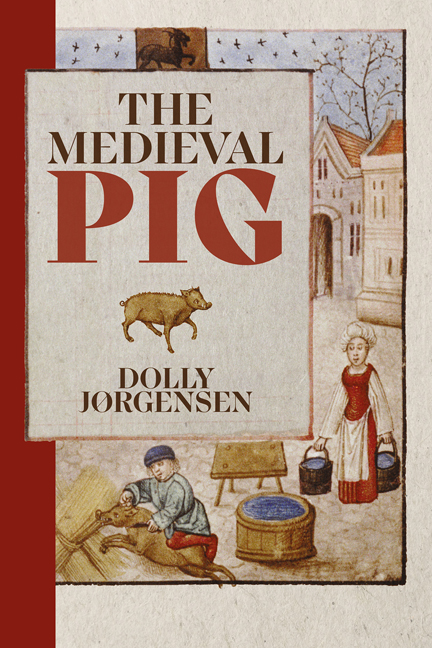4 - On the Plate
Published online by Cambridge University Press: 11 May 2024
Summary
A butcher str addles the pig on the building floor, holding its front leg safely out of the way. With his knife, he slits the pig's throat with precision so that the precious blood gushes into a waiting pan held by a woman. The blood will be transformed into culinary treats and hearty meals. Next to the couple is another pair of butchers carving up a pig carcass. The slaughter, portrayed in a manuscript calendar for the month of December (Figure 14), takes place late in the year as a way of stocking the food stores and reducing the number of mouths to feed over the lean months. This is an image of medieval pig butchery to keep in mind in this chapter. It was a visceral, physical process with close contact between human and pig.
The late fourteenth-century French poet Eustache Deschamps wrote a ballad about pigs extolling their place in medieval society. Its refrain, ‘A pig does no good in its life’ (Pourcel ne fist bien en sa vie), sums up the medieval relationship with pigs. As demonstrated in the previous two chapters, pigs required much attention because they tended to behave badly if not controlled. Deschamps lists the many useful things from pigs, including pork back, neck, hams, sausages, lard, and pork fillets – all of which come from the dead pig. The pig may not have done good in its life, but it did come to do good in its death.
The demand for pork
The reason pigs were kept as livestock was to produce meat. Dietary records of medieval times indicate widespread consumption of pork. Archaeological data from medieval England indicates that pigs were consumed equally in both rural areas and towns. Pig bones occur less frequently than either cattle or sheep, but they are still significant, making up 10–20 per cent of the bones recovered. In Basque areas, pig bones are about 10 per cent of the total recovered bones. Norwegian excavations have similarly shown 5 to 15 per cent of the bones to be swine. Similar numbers are found in the Anglo-Saxon period: in Dorchester, England, from the sixth until the eleventh century 13 to 16 per cent of all animal bones in refuse were pig bones; at Cheddar, pig provided 30 per cent of the meat consumed from 980 to the eleventh century.
- Type
- Chapter
- Information
- The Medieval Pig , pp. 43 - 56Publisher: Boydell & BrewerPrint publication year: 2024

